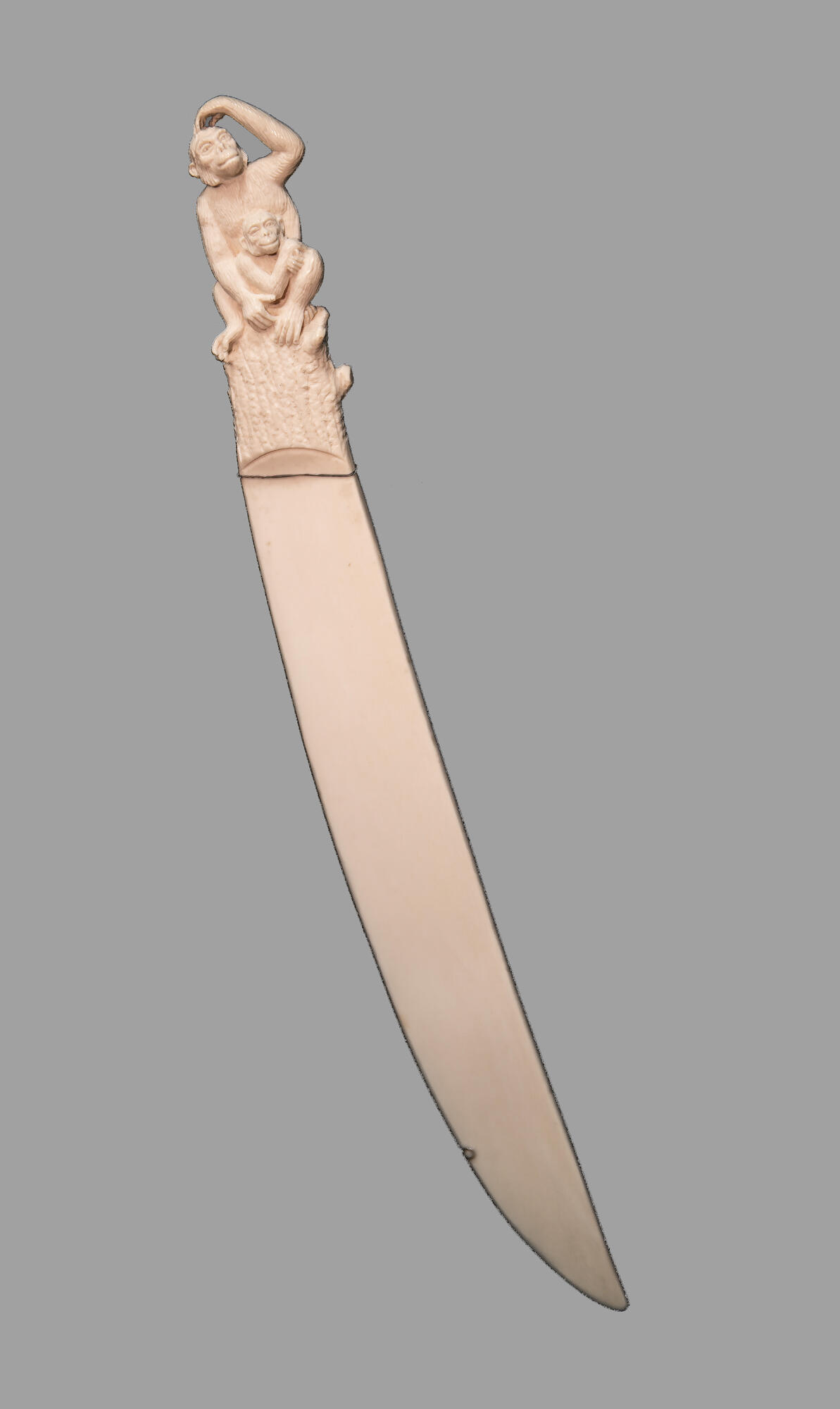The collection of knives came to the funds of the Tobolsk Museum of Fine Arts in 1928. One of them, a paper-cutting knife, was made in the author’s technique by Tobolsk bone cutter Ivan Oveshkov around the 1880s. Oveshkov used the technique of three-dimensional carving and took a mammoth tusk as the material. The master gave the cutting part of the knife a boat-resembling shape, and made the handle curly. Oveshkov carved a miniature sculpture on it depicting two monkeys, an adult, and a cub sitting on a stump. The master separated the stump from the blade with an inset oval line and a zigzag engraving.
The author of the work is Ivan Oveshkov, a provincial surveyor. Initially, he was engaged in archeology and ethnography of the Tobolsk province. During his travels, he studied the ornaments of the peoples of the North and their carvings on mammoth bone. In the future, he himself learned this art. In 1874, a bone-cutting workshop was opened in Tobolsk by Sofya Oveshkova, the master’s wife, in which he worked, and a little later both Oveshkova’s sons began to work here. The workshop owner was engaged not only in administrative matters, but also in artistic management. Clear and precise elaboration of details of miniature round sculptures and Northern motifs in the stories became the distinctive features of the workshop by Sofia Oveshkova.
Ivan Oveshkov owns the paper-cutting knives presented in the exhibition with a handle in the form of mammoth, deer, or bear heads. In 1887, the products of Oveshkova’s Tobolsk bone-cutting workshop were awarded an honorary review at the Siberian-Ural Exhibition in Yekaterinburg. In 1890, the products received a bronze medal at the Kazan Exhibition followed by a commendable review at the Nizhny Novgorod Exhibition in 1895 where the workshop exhibited about 300 items.
The workshop’s works, which had practical applications, were ordered from St. Petersburg, Tyumen, Kurgan, and other cities. The undertaking’s annual turnover by 1896 was about 4,000 rubles. Orders, including for such knives, began to arrive not only from Central Russia, but also from abroad.
At the turn of the 18th - 19th centuries, special paper-cutting knives were created and became quite popular. The need for them appeared because of books. Freshly printed books just out of the store could not be easily opened and read. Due to the lack of hydraulic presses and knives that could cut the entire thickness of the book block, the book production procedure was conducted in several stages. A large-format sheet folded several times was stitched and attached to others. Then the resulting brochure was transferred to binding. Eventually, a finished book appeared, the pages of which were not cut. The solution to this problem was special knives that were made of bone, wood, and metal.
The author of the work is Ivan Oveshkov, a provincial surveyor. Initially, he was engaged in archeology and ethnography of the Tobolsk province. During his travels, he studied the ornaments of the peoples of the North and their carvings on mammoth bone. In the future, he himself learned this art. In 1874, a bone-cutting workshop was opened in Tobolsk by Sofya Oveshkova, the master’s wife, in which he worked, and a little later both Oveshkova’s sons began to work here. The workshop owner was engaged not only in administrative matters, but also in artistic management. Clear and precise elaboration of details of miniature round sculptures and Northern motifs in the stories became the distinctive features of the workshop by Sofia Oveshkova.
Ivan Oveshkov owns the paper-cutting knives presented in the exhibition with a handle in the form of mammoth, deer, or bear heads. In 1887, the products of Oveshkova’s Tobolsk bone-cutting workshop were awarded an honorary review at the Siberian-Ural Exhibition in Yekaterinburg. In 1890, the products received a bronze medal at the Kazan Exhibition followed by a commendable review at the Nizhny Novgorod Exhibition in 1895 where the workshop exhibited about 300 items.
The workshop’s works, which had practical applications, were ordered from St. Petersburg, Tyumen, Kurgan, and other cities. The undertaking’s annual turnover by 1896 was about 4,000 rubles. Orders, including for such knives, began to arrive not only from Central Russia, but also from abroad.
At the turn of the 18th - 19th centuries, special paper-cutting knives were created and became quite popular. The need for them appeared because of books. Freshly printed books just out of the store could not be easily opened and read. Due to the lack of hydraulic presses and knives that could cut the entire thickness of the book block, the book production procedure was conducted in several stages. A large-format sheet folded several times was stitched and attached to others. Then the resulting brochure was transferred to binding. Eventually, a finished book appeared, the pages of which were not cut. The solution to this problem was special knives that were made of bone, wood, and metal.




